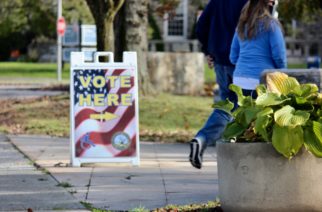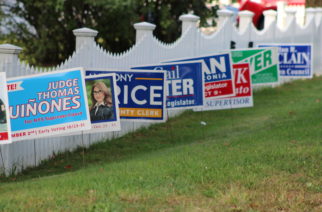The LIRR third track story is just beginning
To the editor:
Governor Andrew Cuomo’s latest announcements that no homes will be taken and seven grade crossings will be eliminated as part of the Metropolitan Transportation Authority’s Long Island Rail Road Main Line Third Track project were lacking specific details. The same is true for MTA’s claim that by using the same contractor for both design and construction, it will save both time and money, resulting in only a five-year construction duration. This may be unrealistic.
Both Governor Cuomo and the MTA/LIRR claiming that they can fast track this project for $1.5 billion is wishful thinking. The current cost estimate is based upon previous outdated planning feasibility studies from over ten years ago. There is little environmental and no preliminary or final design and engineering efforts necessary to validate any actual construction costs. They will need to be refined as the project progresses beyond the planning and environmental phases into real and final design efforts. Value engineering, which is a process used to reduce costs, will be needed during the final design phase.
Unfortunately, history has shown that estimated costs for construction usually trend upward as projects mature toward 100 percent final design completion. Progression of final design refines the detailed scope of work necessary to support construction. The anticipated final potential cost will never be known until completion. Costs will be further refined by a ward of construction contracts followed by any unforeseen site conditions and change orders to the base contracts during the course of construction.
It could easily cost $700 million to a $1 billion more than the $1.5 billion to cover costs of elevating or sinking roadways at 7 crossings (three in New Hyde Park, two in Mineola and two in Westbury) within the existing right of way.
Cuomo is only advocating providing seed money of $7 million to support planning, preliminary design and engineering along with environmental work within the proposed 2015- 2019 MTA Five Year Capital Program. This still needs approval by Albany Capital Program Review Board. Don’t be surprised if the balance of $1.5 billion is higher to support property acquisition of up to 30 businesses, final design and engineering, third party construction and construction management oversight. There is also the need for contingency funding (usually 5 percent to 10 percent of the total project cost to deal with bids that come in above the engineers’ estimates, along with change orders to construction, construction management and other contracts). Add another $700 million to a $1 billion for elimination of 7 grade crossings. You are now looking at a potential project cost between $2.2 to $2.5 billion! These costs may have to be spread out between the 2020-2024 and 2025-2029 future Five Year Capital Programs. (Remember that LIRR Eastside Access started at $3.5 billion in 1999 and has grown to $10.8 billion today and how much more tomorrow. Funding to date has been spread out over three Five Year Capital Programs and will end up being programmed over five Five Year Capital Programs upon completion in 2023 or later.)
MTA LIRR plans to use “design build” as a means to both save money and complete construction within five years. This has pros and cons. Tradition has most projects reach 100 percent final design reviewed and approved by both user groups (various LIRR departments including communications, maintenance, power, track and signal) and all permitting agencies. Design Build brings the project up to 30 percent final design before being bid. The winning contractor advances the project up to 100 percent design in parallel with construction. There are potential problems with fast tracking projects with the design/build process. Consider the clear conflict of interest when the same firm performs both final design and construction. When change orders occur as a result of design error, omission or unforeseen site conditions, will the company voluntarily report and pay for their own mistakes? It is the equivalent of the fox watching the hen house.
The LIRR will have to hire engineering construction management oversight firms, along with additional in-house engineers and procurement specialists to protect their interests. They monitor quality assurance and quality control to insure that the contractor adheres to the original design specifications. These resources are also needed for review and approval of change orders to insure that they are both fair and reasonable. Change orders can result in significantly higher project costs above the winning design and construction firms base bid. If this design/build process has been so successful, you have to ask why the MTA and LIRR did not commit more projects to this method under previous Five Year Capital Plans.
Various LIRR departments including communications, power, track and signal will have to insure that any design by the contractor is compatible with existing equipment and systems already in place. Remember that each LIRR department will have to use and maintain what the contractor delivers, builds and installs.
The MTA and LIRR will most likely use a combination of local and federal dollars to come up with $2.2 to $2.5 billion. Each year, the MTA receives over $1 billion in formula funding from the United States Department of Transportation (USDOT) and Federal Transit Administration (FTA). These funds account for 35 percent of the MTA’s Capital Program. In addition, over the past ten years they received several billion in USDOT FTA New Starts funding for both East Side Access and Second Avenue Subway. It does not include several billion in USDOT FTA Hurricane Sandy relief and recovery funding. The MTA allocates 15 percent or $150 million of over $1 billion in annual formula transit funding from USDOT FTA for the LIRR capital program. These dollars are usually used for routine state of good repair and safety projects. Reprogramming a significant portion of these dollars to support Main Line Third Track would impact the FTA funded LIRR state of good repair and safety capital projects program.
Perhaps the MTA may try to qualify LIRR’s Main Line Third Track Project into USDOT’S FTA New Starts program. Regardless of the funding source, LIRR Main Line Third Track will end up competing against many other worthy projects for funding out of the next MTA Five Year 2020 – 2024 Capital Plan.
This could include, but is not limited to; the 2nd Avenue Subway Phase 2 ($5.5 to $6 billion), Metro North West Bronx Penn Station Access ($200 million), Staten Island North Shore Bus Rapid Transit ($600 million), Queens Woodhaven Blvd. Bus Rapid Transit ($400 million), Rockland-Westchester Tappan Zee Bridge Bus Rapid Transit which would feed into the Metro North Hudson Line Tarrytown Station ($200 million) and Western Queens Montauk Branch Light Rail ($100 million) just to name a few.
Don’t forget future electrification of LIRR service on the Port Jefferson branch from Huntington to Port Jefferson ($360 million), on the Montauk line from Babylon to Speonk ($360 million), on the Ronkonkoma line from Ronkonkoma to Yaphank ($120 million) and Oyster Bay to Mineola ($120 million) is needed. All four combined could easily cost almost $1 billion. This does not include several hundred million for a new storage yard on the Port Jefferson Yard to support electric multiple unit MU cars. All would provide a one seat ride for service to Grand Central Terminal making the LIRR more attractive to current and future riders.
The original proposed previous 2010 – 2014 MTA $29 billion Five Year Capital Plan was cut to $24.2 billion before being approved. The original proposed 2015 – 2019 MTA $32 billion Five Year Capital Plan in September 2014 was rejected by the New York State MTA Capital Program Review Board (CPRB). In October 2015, a revised $28 billion 2015 – 2019 MTA Five Year Capital Plan was approved by the MTA Board. It still needs approval by the NYS MTA CPRB. A majority of the $9 billion in deferred capital improvements cut from these two plans will be still be looking for funding. Don’t forget billions needed for routine state of good repair projects and programs for each operating agency.
Assuming the MTA LIRR elect to pursue federal funding, they will have to comply with the National Environmental Protect Act (NEPA). Depending upon whether FTA determines that Main Line Third Track requires either an Environmental Assessment (EA) or more likely a full blown Environmental Impact Statement (EIS), completion of this process can easily take one to two years. Remember that there is significant local community opposition whose concerns will have to be addressed during the environmental review process. What remedial actions will the MTA/LIRR provide to address this issue? Once FTA issues an environmental finding, the project usually proceeds from 30 percent to 100 percent final design and engineering. Final design and engineering could easily take two years. Add another year for the procurement process to be completed from development of bid specifications, contract advertisement and award. The MTA/LIRR would not initiate the procurement process until funding is actually approved as part of the next the MTA 2020 – 2024 Five Year Plan. Based upon past history in delays for approval of previous Five Year Capital Plans, this might not happen until 2021. As a result, it is possible for the procurement process not to be completed until 2022. Let us assume the MTA/LIRR awards a contract and issues a notice to proceed in 2022. The winning “design/build” construction contractor would begin mobilization of forces and starts work in 2022. Even in the best case scenario put forward by MTA/LIRR, work would not be completed until five years later in 2027. It is far more realistic based upon such a complex project that work may not be finished until 2028 or 2029.
Over the past 30 years, estimates for construction of Main Line Third Track have grown from $600 million to $1.5 billion today. Governor Cuomo admitted that by reducing the amount of private property acquisition, virtually all construction will take place along the existing right-of-way. He went on to say that this will result in increasing construction costs. Now Governor Cuomo has committed that 100 percent of work would be performed on the existing right-of-way. When you combine this with elimination of seven grade crossing, clearly overall project costs are only going to grow even more. This is an incredibly complex project to perform 100 percent of the work within two active tracks. There are 194 weekday and 152 weekend trains serving riders on the Huntington/Port Jefferson, Oyster Bay, Ronkonkoma and Babylon to Speonk branches. This does not include additional freight trains and movements of passenger trains not in service. Completion of double tracking on the Ronkonkoma line with introduction of 30 minute off peak service by 2018 will add two dozen or more trains each day operating on the Main Line. Construction has to proceed in parallel with the MTA/LIRR having to maintain existing passenger and freight service. It is the equivalent of performing heart surgery while the patient is running a 26 mile marathon! No one knows really knows today what the final project cost will be to cover costs of construction or the time needed to complete all work within the existing right of way. Besides relocating two existing tracks on portions of the Main Line to make room for construction a new third track, you have to deal with noise abatement and sound barriers along with additional safety improvements at grade crossings including elevating or sinking tracks at seven grade crossings. Don’t forget LIRR force account support to provide flagging protection. This is necessary to afford Third Party contractors safe access who perform construction within an active right of way corridor. Imagine how many times per hour they will have to stop work when a train passes by? A significant portion of construction work may have to take place evenings, overnight and on weekends when there is less activity on the Main Line. Each grade crossing elimination may require several full blown weekend track outages resulting in full suspension of service on the Main Line. There will be a need for a 24/7 shuttle bus service between Jamaica and Mineola or Hicksville. Costs for substitute bus service could easily run into the millions over the five or more year project construction duration.
The current proposal announced by both Governor Cuomo, the MTA & LIRR this past January is still just conceptual. They have yet to initiate a basic planning study or environmental work. This is still dependent on approval by CPRB of the initial $7 million in seed money. That is why the MTA or LIRR have no detailed project budget to share with anyone other than some news releases. A real project budget would include the estimated costs for each project component. This information is needed if the MTA/LIRR wish to build credibility with commuters, residents, taxpayers, transit advocates, elected officials and the media. Ditto for any project implementation schedule from start to finish. The current proposed project budget is nothing more than a number written on the back of an envelope. Progression for development of Main Line Third Track is like reading a novel. We are still on the first page of the first chapter with many more chapters to go until reaching the end of our story concerning Main Line Third Track.
Larry Penner
Great Neck
Penner is a transportation historian and advocate
who previously worked in the transportation field for 31 years










